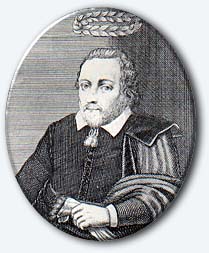 |
   Philip
Massinger was born in 1583 to Anne
and Arthur Massinger. He was the second of five children, and the only
boy. He was baptized in the church of St. Thomas, Salisbury,
on November 24, 1583. His father had earned a B.A. from St. Alban Hall,
Oxford, become a fellow of Merton College, and received
his M.A. from Oxford and Cambridge
both. Arthur Massinger was a long-time trusted servant first to Sir
Henry Herbert, 2nd Earl of Pembroke, and then to his heir Sir William
Herbert, 3rd Earl of Pembroke, until Arthur's death in 1603. Philip
Massinger was born in 1583 to Anne
and Arthur Massinger. He was the second of five children, and the only
boy. He was baptized in the church of St. Thomas, Salisbury,
on November 24, 1583. His father had earned a B.A. from St. Alban Hall,
Oxford, become a fellow of Merton College, and received
his M.A. from Oxford and Cambridge
both. Arthur Massinger was a long-time trusted servant first to Sir
Henry Herbert, 2nd Earl of Pembroke, and then to his heir Sir William
Herbert, 3rd Earl of Pembroke, until Arthur's death in 1603. On May 14, 1602, Philip Massinger entered as a commoner of St. Alban Hall, Oxford. The Earl of Pembroke paid his college expenses during the four years he spent there. He displeased his patron, however, by paying more attention to the study of poetry and romances than to the study of philosophy and logic, as his patron had intended. Massinger left Oxford without taking a degree, and came to London in 1606. There are no records of his life from that time until 1613 when he is mentioned in Philip Henslowe's Diary. Scholars have assumed that Massinger became John Fletcher's primary collaborator after 1613 when Beaumont got married and retired from the theatre. In 1613, Massinger, Nathan Field, and Robert Daborne, in prison for debt, wrote to Henslowe requesting a loan, to be repaid from the play they were writing with Fletcher.1 In 1615, Massinger made a bid for patronage to Sir William Herbert, now Lord Chamberlain, but it is not known if the plea was answered. Around 1618, Massinger collaborated with Thomas Middleton and William Rowley on The Old Law and with Nathan Field in The Fatal Dowry (c.1616-1619), a domestic tragedy set in France. His collaborations were many, including a collaboration with Thomas Dekker on The Virgin Martyr (1620), a history play about the persecution of Christians under the Emperor Diocletian, but most cannot be attributed to him unquestionably, or have since been lost. Massinger's collaboration with Fletcher, begun around 1613 and ending at Fletcher's death in 1625, spanned some 20 plays, including The Custom of the Country (c.1619), The False One (c. 1620), The Beggar's Bush (1622), and The Spanish Curate. Massinger had also become an independent playwright around 1620, and was mentioned in John Taylor's "The Praise of Hemp-Seed" as a contemporary writer of merit. He wrote at least two independent works for the King's Men, the leading theatre company. Exact date of composition is not known, but these included The Duke of Milan (1621? pub. 1623) and The Unnatural Combat, not printed until 1639, but composed around this time. Massinger also wrote at least two independent plays at this time for the Queen of Bohemia's Men at the Phoenix. The Bondman, which criticized the Duke of Buckingham, was acted before the court in December 1623, and won him a slight stipend from Sir Philip Herbert, Earl of Montgomery, which was paid to Massinger's wife (of whom nothing else is known) after his death. The Renegado (1624, pub. 1630) was a sympathetic portrayal of a Jesuit priest, a daring subject in the anti-Catholic London. The Maid of Honour (c.1621?), A New Way to Pay Old Debts (c.1622), and The Great Duke of Florence (1627) were also performed at the Phoenix. In 1625, Massinger replaced Fletcher as chief playwright of the King's Men. His first play under Charles I (King James having died in 1625) was The Roman Actor (1626), a tragedy about the Emperor Domitian. This Massinger himself considered his best play, as he wrote in the 1629 dedication that he "ever held it the most perfect birth of my Minerva." In 1631, Massinger ran afoul of the censor with his play Believe as You List, because in it Spain and England declared peace. Massinger changed the names of characters and places, and it was licensed, but Massinger never released it for publishing. The play, still extant in manuscript, with the censor's notes and all its changes in Massinger's hand, affords valuable insight into censorship and the process of playwriting at the time. After 1630, Massinger wrote numerous plays, all for the King's Men. Unfortunately, a great number of them have been lost and only exist as little more than titles and dates of license. Of the ones that remain, worth mention is The City Madam (1632), a citizen comedy that depicts Caroline society at several levels. All of Massinger's extant plays were written by 1636. On March 18, 1640, Massinger was found dead in his bed, having been well the night before. His body was laid to rest in S. Saviour's Church, Southwark, (now Southwark Cathedral), as it is told, in the same grave with the bones of his friend John Fletcher. Editions and Criticism The Poems of Philip Massinger, with Critical Notes. Donald S. Lawless, ed. Ball State Monograph 13. Muncie, Ind.: Ball State University, 1968.  The Plays and Poems of Philip Massinger. Philip Edward and Colin Gibson, eds. Oxford: Clarendon Press, 1976.
Sources:
 Massinger | Works | Links | Essays | Books | Early 17th C. Literature
|
